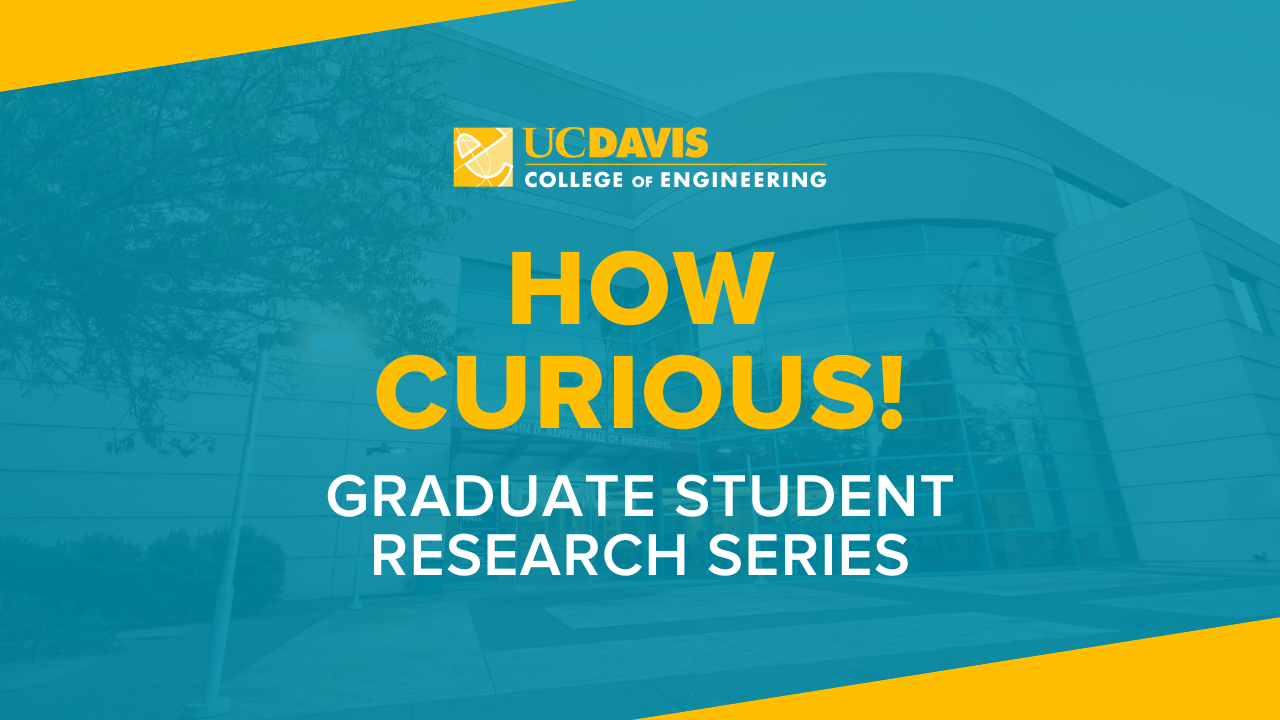
Event Date
How Curious! offers graduate students in master's and Ph.D. programs in the College of Engineering an opportunity to present their research findings and engage in scholarly discussions with their peers and faculty members. The goal is to foster collaboration, encourage intellectual exchange and support the professional development of our graduate student community.
Presenters
Abigail Hering, Materials Science and Engineering
Presenting: Forecasting halide perovskite degradation with machine learning
The degradation and changeable properties of halide perovskites in response to environmental stressors (such as humidity, temperature, oxygen, light, and bias) are current pressing issues that are halting their use in sustainable optoelectronic devices. The degradation mechanisms are not well understood due to the immense composition parameter space involved [1,2]. In order to quantify the degradation of several different perovskite compositions, we use a custom-built, high throughput, in situ photoluminescence (PL) characterization to collect sufficient data to train a variety of machine learning (ML) models. We compare forecasts of PL of several CsyFA1-yPb(BrxI1-x)3 perovskites in response to relative humidity and temperature cycling with linear regression (LR), echo state network (ESN), and seasonal autoregressive integrated moving average with exogenous regressors (SARIMAX), and convolutional neural network (CNN) algorithms. Overall, we find that these models enable predictions of PL figures of merit, such as peak location, intensity, and full-width half max (FWHM), with up to 90% accuracy [3]. This time-series forecasting can be applied to improve the design and accelerate the implementation of hybrid perovskites for energy materials. The development of high- throughput hardware and ML algorithms proposed here is a generalizable pipeline for accelerating energy materials discovery [4]. [1] M. Srivastava et al. J. Phys. Chem. Lett. 2021, 12, 7866−7877 [2] J. M. Howard
Bio: Abigail is a third-year Ph.D. student in the Department of Materials Science and Engineering, advised by Professor Marina Leite. Her research focuses on characterizing the optical properties of halide perovskites and using machine learning as a tool to forecast perovskite material degradation. Her research has been published in ACS Energy Letters and APL Energy, and she has presented at MRS, ACS, and SPIE conferences.
Toulik Maitra, Chemical Engineering
Presenting: Rethinking Inelastic Neutron Scattering Spectra Analysis - A Progressive Approach for Phonon Analysis of Organic Electronic Materials
Organic electronic materials (OEMs) are crucial components in modern display technologies and photovoltaics(PV) applications. Despite their importance, OEMs face challenges in achieving the same charge carrier mobility as inorganic semiconductors, limiting device efficiency. Among the contributing factors, phonons play a significant role in restricting mobility in OEMs and gaining a deeper comprehension of their behaviour is imperative. Several experimental methods, such as Raman scattering, infrared (IR) spectroscopy, and Inelastic Neutron Scattering (INS), are utilized to explore phonon modes. INS, with its advantages including the absence of selection rules and the ability to probe a wide energy range (5-8000 cm^-1), emerges as a particularly promising technique. Understanding INS spectra traditionally rely on simulating phonon modes through methods like Density Functional Theory (DFT), known for its remarkable accuracy. However, DFT encounters limitations when dealing with intricate and large systems, making it impractical for simulating polymers or sizable small-molecule structures. This presentation introduces an approach for analyzing INS spectra without resorting to simulations. We present insights into crucial microscopic material properties, particularly crystallinity and contributions arising from backbone disorder. This work represents a vital step towards unlocking the full potential of analyzing INS spectra.
Bio: Toulik, a second-year PhD student in the Department of Chemical Engineering under the guidance of Professor Aam Moule, primarily focuses his research on the analysis and enhancement of organic semiconducting materials compared to their inorganic counterparts. One approach he employs involves examining the phonon spectrum of compounds through techniques such as Inelastic Neutron Scattering. Additionally, he explores various material simulations utilizing mathematical modeling and Density Functional Theory (DFT). His past projects include investigating hierarchical nanostructures for applications in photovoltaics and hydrochemical water-splitting. Toulik has contributed to the co-authorship of five research articles published in esteemed peer-reviewed journals such as ACS and RSC.
Andrew Arends, Mechanical and Aerospace Engineering
Presenting: Astronaut-Powered Laundry Machine
Without a precedent to laundering clothes off-Earth, a preliminary solution is required to develop a spaceflight laundry machine capable of operating in various gravity fields. The researcher's proposed solution uses human exercise to power an agitating bladder, a closed-loop hydraulic system, and a wastewater sensor suite to provide a desirable environment for quantifying waste-mass transfer away from textiles while minimizing textile damage. Bond Graph Theory is used to model the proposed solution and to evaluate how human-power and valve configurations affect the system’s cleaning performance. Bond Graph simulation results reveal preliminary performance metrics and hardware significantly impacting the machine’s performance. A human-powered laundry machine prototype and model have been created and are essential for maturing the technology to Spaceflight readiness.
Bio: Andrew is a first-year Ph.D. student in the Department of Mechanical and Aerospace Engineering (MAE), advised by Dr. Stephen Robinson. Andrew received two High Honors B.S. degrees in MAE in December 2020 and a M.S. in MAE in March 2024 from UC Davis, and he has also been a NASA employee since 2019, working on motion simulators before transitioning to life support systems in 2024. His research focuses on technology for living and working in space and has been published by the International Conference on Environmental Systems.
